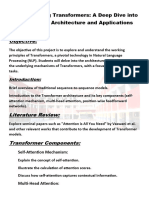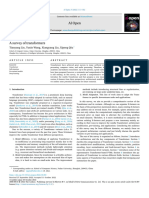0% found this document useful (0 votes)
12 views1 pageTransformet Notes
Transformers, introduced in 2017, revolutionized NLP by utilizing self-attention instead of recurrence, forming the basis for models like BERT and GPT. They process tokens in parallel, allowing for efficient context understanding through attention mechanisms. The architecture consists of an Encoder-Decoder structure, with modern models often using only the encoder or decoder for specific tasks.
Uploaded by
ApuCopyright
© © All Rights Reserved
We take content rights seriously. If you suspect this is your content, claim it here.
Available Formats
Download as TXT, PDF, TXT or read online on Scribd
0% found this document useful (0 votes)
12 views1 pageTransformet Notes
Transformers, introduced in 2017, revolutionized NLP by utilizing self-attention instead of recurrence, forming the basis for models like BERT and GPT. They process tokens in parallel, allowing for efficient context understanding through attention mechanisms. The architecture consists of an Encoder-Decoder structure, with modern models often using only the encoder or decoder for specific tasks.
Uploaded by
ApuCopyright
© © All Rights Reserved
We take content rights seriously. If you suspect this is your content, claim it here.
Available Formats
Download as TXT, PDF, TXT or read online on Scribd
/ 1
































































